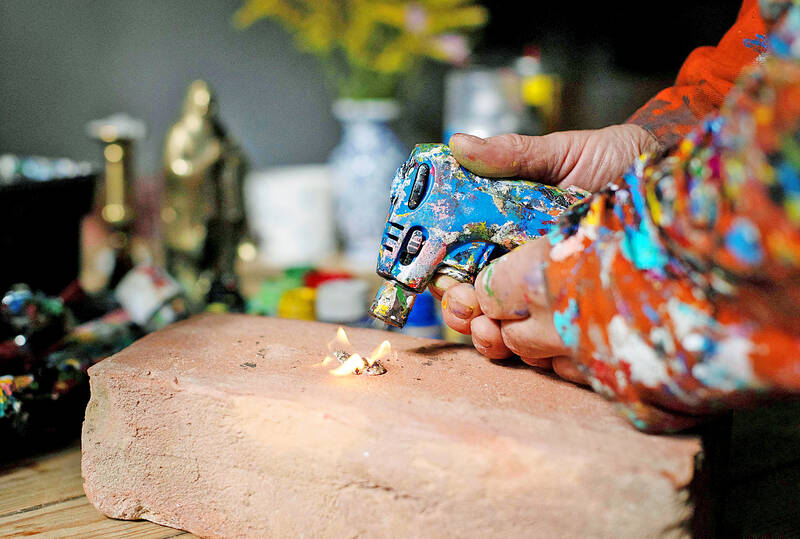Lying on his side on the surface of London’s iconic Millennium Bridge, artist Ben Wilson paints a piece of dried chewing gum trodden into the ground.
“The important thing is the gum is below the metal tread,” said 60-year-old Wilson, dressed in a paint-daubed orange jumpsuit. “The beauty of it is they’re all different shapes and sizes so there’s no conformity.”
What most people actively avoid or simply don’t see, Wilson views as an opportunity to turn a tiny piece of discarded rubbish into something beautiful. It’s also a way to delight passersby, enticing them to take a closer look underfoot.

Photo: Reuters
“By painting a picture which is so small, those that see it then discover a hidden world beneath their feet,” Wilson said.
“If they look then they see, so it’s about perception.”
Back in his north London studio, Wilson paints on the surface of a small mosaic tile which will be part of a collection that he sticks on the walls of London’s Underground train platforms, hidden in plain sight. The images are more personal than the chewing gum works, Wilson says, and represent

Photo: Reuters
an “intuitive visual diary.”
“The pictures are a celebration of my life and those that I care dearly about ... they are (also) a process of visual inquiry — trying to make sense of the world,” he said.
London-born Wilson was raised by artist parents and recalls working with clay from age three, with his first artist show at around 10 or 11 years old.

Photo: Reuters
His artwork developed into sculpture and large pieces in the natural environment before his interest turned to rubbish and discarded items from a consumerist world, like chewing gum, which he’s been painting for 19 years.
The top surface of the dried gum is not subject to local or national jurisdictions, creating a space where Wilson says he can paint without defacing public property.
“I found this little space where I could create a form of art where I could be spontaneous and do something which evolves out of the place in which it’s created,” Wilson said.
The artist has had much of his public street art removed by authorities — gum from the pavement or tiles from the Underground — but the hundreds of gum paintings on Millennium Bridge have been left untouched.

The Directorate-General of Budget, Accounting and Statistics (DGBAS) told legislators last week that because the Chinese Nationalist Party (KMT) and Taiwan People’s Party (TPP) are continuing to block next year’s budget from passing, the nation could lose 1.5 percent of its GDP growth next year. According to the DGBAS report, officials presented to the legislature, the 2026 budget proposal includes NT$299.2 billion in funding for new projects and funding increases for various government functions. This funding only becomes available when the legislature approves it. The DGBAS estimates that every NT$10 billion in government money not spent shaves 0.05 percent off

Dec. 29 to Jan. 4 Like the Taoist Baode Temple (保德宮) featured in last week’s column, there’s little at first glance to suggest that Taipei’s Independence Presbyterian Church in Xinbeitou (自立長老會新北投教會) has Indigenous roots. One hint is a small sign on the facade reading “Ketagalan Presbyterian Mission Association” — Ketagalan being an collective term for the Pingpu (plains Indigenous) groups who once inhabited much of northern Taiwan. Inside, a display on the back wall introduces the congregation’s founder Pan Shui-tu (潘水土), a member of the Pingpu settlement of Kipatauw, and provides information about the Ketagalan and their early involvement with Christianity. Most

The People’s Republic of China (PRC) was out in force in the Taiwan Strait this week, threatening Taiwan with live-fire exercises, aircraft incursions and tedious claims to ownership. The reaction to the PRC’s blockade and decapitation strike exercises offer numerous lessons, if only we are willing to be taught. Reading the commentary on PRC behavior is like reading Bible interpretation across a range of Christian denominations: the text is recast to mean what the interpreter wants it to mean. Many PRC believers contended that the drills, obviously scheduled in advance, were aimed at the recent arms offer to Taiwan by the

Like many retirement communities, The Terraces serves as a tranquil refuge for a nucleus of older people who no longer can travel to faraway places or engage in bold adventures. But they can still be thrust back to their days of wanderlust and thrill-seeking whenever caretakers at the community in Los Gatos, California, schedule a date for residents — many of whom are in their 80s and 90s — to take turns donning virtual reality headsets. Within a matter of minutes, the headsets can transport them to Europe, immerse them in the ocean depths or send them soaring on breathtaking hang-gliding expeditions